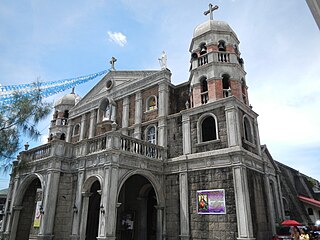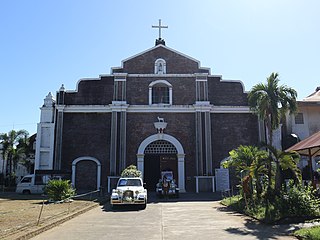
The Baroque Churches of the Philippines are a collection of four Spanish Colonial-era baroque churches in the Philippines, which were included in UNESCO's World Heritage List in 1993. The churches are also considered as national cultural treasures of the country.

The Augustinian Province of Sto. Niño de Cebu, based in Cebu City, Philippines, is a geographical and administrative subdivision of the religious Order of St. Augustine. The Province is actively involved in education, parish administration, mission work and formation of candidates for religious life. It has worked on joint missions with other Augustinian provinces, namely, the Australian Province in South Korea, the Dutch Province in Indonesia, and the Provinces of Villanova, Ireland and England-Scotland in South Africa. In keeping with its goal to become a missionary Province, it has begun sending friars overseas to help in apostolic and pastoral ministries.

The Cathedral-Basilica Minore and Parish of the Immaculate Conception, commonly known as Malolos Cathedral, is a Roman Catholic minor basilica and cathedral in the city of Malolos, Bulacan in the Philippines. The cathedral is the see of the Bishop of Malolos, a suffragan of the Archdiocese of Manila. The shrine is dedicated to the Blessed Virgin Mary of the Immaculate Conception.

Our Lady of Remedies Parish, commonly known as Malate Church, is a Roman Catholic parish church in the district of Malate in the city of Manila, Philippines. It is under the jurisdiction of the Archdiocese of Manila. This Mexican Baroque-style church is overlooking Plaza Rajah Sulayman and, ultimately, Manila Bay. The church is dedicated to Nuestra Señora de los Remedios, the patroness of childbirth. A revered statue of the Virgin Mary under this title was brought from Spain in 1624, and is currently enshrined at the high altar.

Immaculate Conception Cathedral, commonly known as Pasig Cathedral, is a Roman Catholic church located in Plaza Rizal, Barangay Malinao, Pasig in Metro Manila, Philippines. It is the mother church, and serves as the episcopal seat of the Bishop of Pasig and is one of the oldest structures in the city.

The National Shrine of the Our Lady of Candles, also known as the Metropolitan Cathedral of Saint Elizabeth of Hungary and colloquially as Jaro Cathedral, is a cathedral located in the district of Jaro in Iloilo City, on the island of Panay in the Philippines. The seat of the Roman Catholic Archdiocese of Jaro, it was placed under the patronage of Saint Elizabeth of Hungary. It was established in 1575 as a visita (chapel-of-ease) of Oton by the Augustinians and as a separate parish in 1587. The present-day structure of Jaro Cathedral was built in 1874.

The Basílica Minore del Santo Niño de Cebú, alternatively known as the Minor Basilica of the Holy Child or simply Santo Niño Basilica, is a minor basilica in Cebu City in the Philippines that was founded in 1565 by Fray Andrés de Urdaneta and Fray Diego de Herrera. It is the oldest Roman Catholic church in the country, allegedly built on the spot where the image of the Santo Niño de Cebú was found during the expedition of Miguel López de Legazpi.

Saint Augustine Parish Church, commonly known as Paoay Church, is a Roman Catholic church in the municipality of Paoay, Ilocos Norte in the Philippines. It is under the jurisdiction of the Diocese of Laoag. Completed in 1710, the church is famous for its distinctive architecture, a highlight of which is the enormous buttresses on the sides and back of the building. It is declared as a National Cultural Treasure by the Philippine government in 1973 and a UNESCO World Heritage Site under the collective group of Baroque Churches of the Philippines in 1993.

Santa Monica Parish Church, commonly known as Minalin Church, is a Baroque Roman Catholic church, located in poblacion area of San Nicolas in Minalin, Pampanga, Philippines. The church, built during the Spanish era, was declared a National Cultural Treasure by the National Commission for Culture and the Arts and the National Museum of the Philippines on August 27, 2011, one of 37 churches in the country bestowed that honor.

The Immaculate Conception Parish Church, also known as Dasmariñas Church, is the first Roman Catholic parish church in the city of Dasmariñas, province of Cavite, Philippines. It is under the jurisdiction of the Diocese of Imus. The stone church was constructed right after the establishment of Dasmariñas as a separate parish in 1866. The church and convent was the site of bloodshed during the Battle of Perez Dasmari ñas of the Philippine revolution against Spain. It was declared as an important historical structure by the National Historical Institute with the placing of a historical marker in 1986.
The 1948 Lady Caycay earthquake occurred at 01:46 PST (UTC+08:00) on 25 January 1948 with an estimated moment magnitude of 7.8 and a maximum Mercalli intensity of X (Extreme). The epicenter was between the municipalities of Anini-y, Antique, and Dao on Panay Island, Philippines.

The Minor Basilica and Parish of the Immaculate Conception, alternatively known as the Archdiocesan Shrine of Santo Niño de Batangan, is a minor basilica in Batangas City, Philippines. It is under the jurisdiction of the Archdiocese of Lipa. It was made an independent parish in 1614 under the advocation of the Immaculate Conception. It is one of the oldest churches in Batangas.

Santo Tomás de Villanueva Parish Church, commonly known as Miagao Church, is a Roman Catholic church located in Miagao, Iloilo, Philippines. It is under the jurisdiction of the Archdiocese of Jaro. The church was declared as a UNESCO World Heritage Site on December 11, 1993, together with San Agustin Church in Manila; Nuestra Señora de la Asuncion Church in Santa Maria, Ilocos Sur; and San Agustin Church in Paoay, Ilocos Norte under the collective title Baroque Churches of the Philippines, a collection of four Baroque Spanish-era churches.

Saint Andrew the Apostle Parish, commonly known as Bacarra Church, is a Roman Catholic church located in the municipality of Bacarra, Ilocos Norte, Philippines under the jurisdiction of the Diocese of Laoag.

Saint Catherine of Alexandria Parish Church, also known as the Shrine of Our Lady of Namacpacan and Namacpacan Church, is a Roman Catholic church located in Luna, La Union, Philippines under the jurisdiction of the Diocese of San Fernando de La Union. Once called Luna Church, its titular is Saint Catherine of Alexandria. Built in 1690, it is also known as the shrine for the image of Our Lady of the Immaculate Conception of Namacpacan.

Immaculate Conception Parish Church, also known as La Purisima Concepcion de la Virgen Maria Parish Church and Baclayon Church, is a Roman Catholic church in the municipality of Baclayon, Bohol, Philippines within the jurisdiction of the Diocese of Tagbilaran. Baclayon was founded by the Jesuit priest Juan de Torres and Gabriel Sánchez in 1596, and became the oldest Christian settlement in Bohol. It was elevated as a parish in 1717 and the present coral stone church was completed in 1727. The Augustinian Recollects succeeded the Jesuits in 1768 and heavily renovated the church since then.

The Archdiocesan Shrine of Santo Niño de Arevalo, also known as the Most Holy Name of Jesus Parish and Arevalo Church, is a Roman Catholic church located in the district of Arevalo in Iloilo City, Philippines. It houses the Santo Niño de Arevalo, the third oldest image of the Holy Child in the Philippines. It is under the Archdiocese of Jaro.

Our Lady of Peace and Good Voyage Parish Church, commonly known as La Paz Church, is a Roman Catholic church located in the district of La Paz in Iloilo City, Philippines. It is under the Archdiocese of Jaro.

San Juan de Sahagun Parish Church, commonly known as Tigbauan Church, is a Roman Catholic parish church located at the municipality of Tigbauan, Iloilo in the Philippines. It is a Churrigueresque-style church and is under the jurisdiction of the Archdiocese of Jaro.
























